  |
 |
 |
 |
|
theartsection
|
 |
|
 |
|
|
 |
|
Louise Bourgeois, Spider
IV, 1996. Bronze, 203.2 x 180.3 x 53.3 cm. Collection The Easton Foundation,
courtesy Hauser & Wirth and Cheim & Read. Photo Peter Bellamy. © Louise
Bourgeois Trust
Bronze at the Royal Academy
By Anna Leung
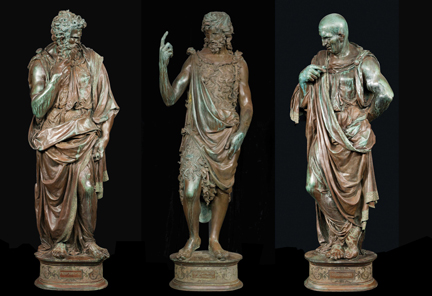
Adriaen
de Vries, Vulcan’s Forge, 1611. Bronze, 47 x 56.5 cm. Bayerisches
Nationalmuseum, Munich. Photo © Bayerisches Nationalmuseum
This advisedly
blockbuster exhibition that is ostensibly competing with Tate’s Pre-Raphaelites: Victorian Avant-Garde show calls upon
the public to view bronze sculpture with new eyes. Given the pall and weight of tradition bronze statuary has had aligned
against it in the modern period, the exhibition comes as a welcome surprise. Largely a return to figurative sculpture it celebrates
not only the versatility and durability of bronze but the archaeologists and collectors who devoted their time and energy
to tracking these bronzes down. Bronze’s capacity for replication makes provenance something of a mystery, which of
course adds to its mystique. ‘Bronze’ brings together over 150 works from four continents that span prehistory
to the present day, mingling legendary masterpieces with less well-known small bronzes, statuettes and devotional pieces.
The exhibition has no particular art historical agenda, nor even a sustained narrative. It is arranged thematically: the human
figure is followed by animals, objects, group sculptures and reliefs, gods and portraits. It cannot, I think, fail to astonish
and more importantly to delight, giving the viewer licence to draw parallels between works separated by time and geography.
Its approach is fundamentally modernist, the versatility of bronze techniques and the show’s presentation of each artefact
isolated from its original context arguing for an underlying universality despite differences in style, form and meaning. Although
the exhibition contains a host of impressive works, including Rustici’s monumental ensemble group St John the Baptist
preaching to a Levite and a Pharisee which may have benefited from the help of Leonardo da Vinci, the two versions of
Perseus and Medusa by Cellini, the first a model and the second a new casting by Clemente Papi from 1844, and Giambologna’s
Mercury, which exemplifies bronze’s capacity to defy gravity, plus all the presumed replicas of Greek statuary
from the late Hellenic and Roman periods that are emulated by Renaissance sculptors on both side of the Alps, it often scores
with the display of less well known sculpture belonging to non European artistic practices. But even within the classic sphere
there are surprises; the highly naturalistic Roman portraits, curls and all; the extremely naturalistic portrait of King
Seuthes, recently unearthed in Bulgaria, and the discovery in 1998 of the Dancing Satyr that exuberantly opens
the exhibition. Possibly part of the loot taken by the Vandals from the sack of Rome in 455CE the Dancing Satyr is
believed by some authorities to be handiwork of no lesser sculptor than Praxiteles in the second half of the fourth century
BC. No other statue can convey with more eloquence the attributes of bronze--its ability to defy gravity and, through the
play of light on its surface, to communicate an endless flow of energy and delight. In a very different key there is the solemn
beauty of Ghiberti’s Tomb Slab of Fra Leonardo Dati (1425-26) with its simple geometric relief that conveys a
moving otherworldliness, the vigour of De Vries’ Forge of Vulcan (1611), as well as Giambologna’s Turkey
and Pietro Tacca’s Il Porcellino whose gleaming snout has been stroked smooth by countless generations of admirers.
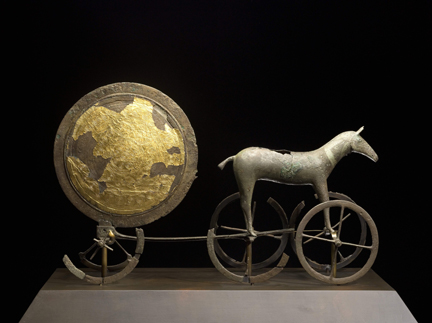
The
Chariot
of the Sun, Trundholm, Zealand, Early Bronze Age, 14th century BCE. Bronze and
gold, 95 x 60 x 25 cm. National Museum, Copenhagen. Photo Roberto Fortuna &
Kira Ursem, The National Museum of Denmark
Bronze is able
to create such a panoply of sculptural forms and textures due to the fact that it is a metal alloy. Basically copper mixed
with a certain percentage of tin, zinc and occasionally arsenic, bronze has a range of coloration, malleability or hardness
and the versatility and durability that have favoured its use throughout history. The down side is that as a result of conquest,
many pieces have been melted down as scrap metal – bronze goes into the creation of cannon balls as well as art works.
The lost wax method of casting is the best-known type of fabrication in bronze. The room in the exhibition given over to explaining
and demonstrating the complicated techniques of casting that make its ancient origins all the more amazing alone makes the
exhibition worth seeing. The earliest cast objects come from the Nahal Mishnar hoard in Israel, which is often associated
with King Solomon’s mines and dates from c. 3700BC. With the rise of cities in Egypt and the fertile crescent of Mesopotamia,
bronze was used mostly for royal and sacred images such as in the devotional statuette of Ptah with its beautiful coloration
and the Seated Cat, which once sported an incised collar and pierced ears. However one of the earliest cult objects
comes not from the Mediterranean basin but from Denmark and is the exquisite Chariot of the Sun that dates from the
fourteenth century BC. A lost wax cast with incised decorative patterning on the day side of its huge golden sun disc drawn
by a horse on wheels, it probably represents the passing of the sun east to west and then, with the oncoming of darkness,
from west to east. Equally spectacular, from the seventh century, is a Cult Chariot from Strettweg in Austria which
displays a large female figure on the chariot, minus the horse, surrounded by a retinue of smaller male and female figures.
There has been a tendency to associate bronze with the
Western classical period, ancient Greek and Roman statuary, an association reinforced by the prestige of the Renaissance that
was to a large extent based on the rediscovery of Italy’s classical heritage or rather the revaluation of its cultural
roots in the idealisation of the standing figure and the nude. But this exhibition demonstrates that the use of bronze was
central to many other civilizations and cultures, and the work on display comes from China, Asia and West Africa as well as
Europe and the Middle East. Early Chinese bronze making is unusual in that it is marked by an absence of tutelary or votive
figures of deities and the like. The standing figure only entered Chinese culture with the adoption of Buddhism, and with
it came the lost wax technique, from the fourth century CE. But from as early as 1500 BC, bronze vessels for ceremonial as
well a functional purposes were being manufactured in series often replicating already highly sophisticated Chinese ceramics.
What distinguishes these multishaped vessels is the artistry of their surface patterning that tends to be made up of semi
abstract motifs against a background of angular spirals that often incorporate strange legendary animals. At a later date,
script was used as both a decorative device and a means of commemorating successful events. The Elephant is one of
the most intriguing of these vessels and was probably intended to store wine, there being a cavity in its back; another that
has a pronounced zoomorphic appearance in the form of a Double Owl dates from the twelfth or eleventh century BC. The
Chinese also used bronze to manufacture bells (Bo) that were grouped together in large numbers and decoratively characterised
by the use of pattern blocks.
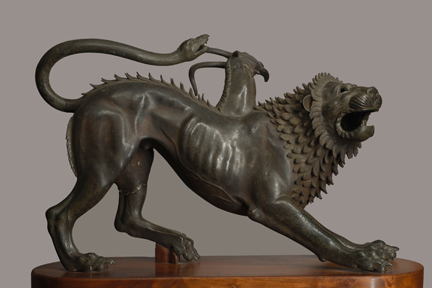
Chimera
of Arezzo, Etruscan, c. 400 BCE Bronze, 78.5 x 129 cm Soprintendenza per i Beni Archeologici della Toscana Photo
Antonio Quattrone, Florence
While bronze making
in China seems to have been almost industrial, elsewhere the metalworker and blacksmith would have been revered for their
alchemical or semi-magical powers. This was certainly the case in South and Southeast India, though few bronzes have survived
from an early period. The Buddha Shakyamuni, which dates from the late sixth century, is an exception. While most of
the sculptural emphasis is on his hand gestures, the way the drapery reveals the figure beneath is very aesthetic in its own
right. This is a relatively large-scale figure. There are many more small devotional ones such as the Korean Pensive Buddha,
which has its own very appealing and distinctive qualities and is quite unlike the ornate Chinese and Tibetan examples of
Buddhist sculpture with their multiple arms and corpulent bodies or the sleek elegance of Cambodian representations of the
Buddha whose aesthetic sensitivity is borne out in the exquisite lotus flower Oil Lamp from the twelfth century. Even
more mysterious are the bronzes from the region around the lower Niger delta that is now part of Nigeria. These beautifully
dignified heads, mostly from Benin and Ife are characterised by an unexpected degree of naturalism and represent an indigenous
tradition of smelting and casting that dates back to the thirteenth and fourteenth centuries. It is to a large extent devotional
or cultish statuary which attests to a highly developed stage of metallurgy. An even earlier work is the Roped Pot on a
Stand, which dates from the ninth or tenth century and has been likened to Faberge in its virtuosity. Its various sections
were probably cast independently and subsequently joined together.
The
prestige attached to bronze goes back to Pliny and the invention of so called ‘Corinthian brass,’ reputedly more
prized than gold and silver. Unlike wood and stone, bronze enjoyed the added status of being man made and needing a team of
skilled craftsmen to complete a bronze work of art, the operative word being skilled rather than mechanical. However by the
twentieth century, the dominant image of the sculptor was that of the solitary artist working directly into wood or stone.
The bronze sculptor’s dependence on teamwork militated against the continued use of the material. This was because two
notions dominated twentieth century modernism: one was the attention given to materials and materiality, the other the notion
of the artist, painter or sculptor, working more or less alone in communion with his or her materials and emotionally responding
to the art work’s creative potential. In addition, the fact that casting allows for the production of multiples even
after the death of the sculptor violated the modernist ideal of the unique and original work and problematised the whole notion
of authorship. Rodin’s posthumous bronzes, for instance, provoked a storm of controversy. By the thirties, Henry Moore
was making a fetish of direct carving, taking his cue from Brancusi who, reacting against Rodin’s celebrity status,
had targeted his bronzes as so much ‘beefsteak’. Later when he had won recognition Brancusi moderated this negative
judgement and produced very beautiful bronzes (Danaide and Maiastra) as did Moore. However Brancusi dispensed with
the contribution of the patinier, who traditionally applied a veneer of colour or patina to the bronze when casting was complete.
Instead he is said to have devoted hours to produce a high polish that was linked in his mind to the sense of the sacred and
to magical or shamanistic flight. For Brancusi’s artistic intentions were not at all the same as Rodin’s. Unlike
Rodin’s, Brancusi’s work was symbolic but not emotive and, more to the point, his bronzes were never conceived
as casts from a previously modelled object and thus did not re-present an already existing image. Nor was his aim to
capture interiority through dramatic movement but rather to capture light that defines not only the object but our perception
of the object with its possibilities of reflection, distortion and sheer intensity; an artistic intention which almost a century
later has been taken up by Anish Kapoor with his Untitled concave mirror that flaunts its bronze pedigree.
|
|
|
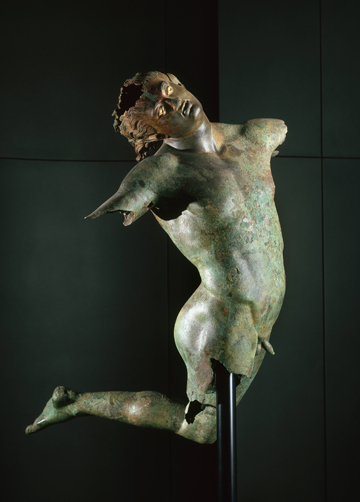
Dancing
Satyr, Greek, Hellenistic period, Third - second centuries BCE Bronze,
with white alabaster for eyes, H. 200 cm Museo
del Satiro, Church of Sant - Egidio, Mazara del Vallo ©
2012. Photo Scala, Florence
Boccioni’s Unique Form
of Continuity in Space, 1913, which might seem to share a sense of modernity with Brancusi’s bronzes was cast posthumously.
An early casualty of the First World War he was never able to realise his revolutionary Futurist ideas that scorned the traditional
use of bronze and in his attempt to narrow the divide between art and life proposed its replacement with everyday materials
such as steel, mirrors, plastic, organic matter and other ready-made functional articles. Ironically it is these everyday
objects that we see incorporated in Picasso’s Baboon and Young, the baboon’s face being made up of Picasso’s
own children’s toy cars, and in David Smith’s witty Portrait of a Painter with his palette standing in
as his head and his paint box as his hand. It is somehow fitting that the one sculptural technique able to accommodate such
revolutionary ideas was bronze casting. Jasper Johns, who possibly had Picasso’s hand painted Absinthe Glass
in mind, applied a similar logic to his painted bronze Ale Cans, 1960, that originated with de Kooning’s comment,
referring to the dealer Leo Castelli, that ‘you could give that son of a bitch two beer cans and he could sell
them’. Johns responded by saying that he thought this a wonderful idea for a sculpture.
The choice not to arrange the exhibition chronologically or geographically creates
an overall feeling of fluidity that aligns sculpture from different cultures. As a result what characterises the exhibition
is its eclecticism and its capacity to create fascinating contrasts and comparisons. Giacometti’s etiolated figures
immediately comes to mind when we see the Etruscan Votive Figure known as Evening Shadow, though Giacometti always
declared his images to be dream readymades. This does not discount the direct impact the strange Etruscan figure would have
made on his imagination. Yashoda Nursing the Infant Krishna has its Christian counterpart in the many Madonnas breast-feeding
the infant Jesus, while the Nigerian gold weights are reminiscent of Japanese netsuke. The numerous figures on horseback as
well as the depiction of animals, horses, leopards and panthers all attest to a universal fascination with animals and their
symbolic standing. The ability to create a mimetic resemblance in bronze can be compared to an illusionist’s conjuring
trick and delights us precisely because we do not see the moves backstage. It seems to be a skill universally admired; that,
plus the sheer aesthetic delight of burnished or patinated bronze, ensures its appeal through out the ages. That bronze can
produce works of art as dissimilar as Rodin’s Age of Bronze, de Kooning’s Clam Diggers, the Nigerian
Seated Figure, Francesco Bertos’ allegorical Sculpture, Arithmetic and Architecturem 1732-39, that seems
to prefigure postmodernist wit, Medardo Rosso’s Ecce Puer, 1906, which was originally modelled in wax, and Jeff
Koons's Basketball, 1985, attests to its virtuosity.
Consequently,
despite the avant gardist-trend for direct carving that dominated the early twentieth century, bronze has continued to hold
its own. It was particularly germane in the post 1945 period when Giacometti’s and Germaine Richier’s roughly
modelled welded figures with their excoriated surfaces seemed to embody a deep underlying malaise. In the twenty-first century,
we have seen sculpture move into the very different areas of installation and performance art and the use of all manner of
materials including frozen blood and dirt. But despite this extraordinary expansion of sculpture, bronze has continued to
attract a wide range of contemporary sculptors from Louise Bourgeois, whose Spider IV links back to Richier’s
Praying Mantis, to Tony Cragg with his Points of View, 2007, that brings together figurative and abstract elements
in a way that only bronze can do.
© Anna Leung, September 2012
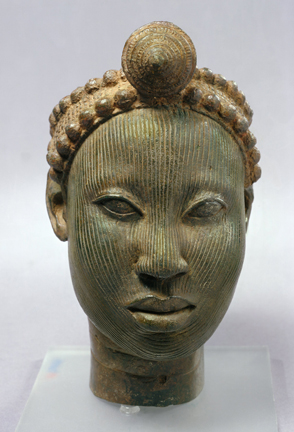
Head
with Crown, 14th to early 15th century Zinc and brass, H. 24 cm The National Commission for Museums and Monuments,
Lagos Copyright 2012. Photo Scala, Florence
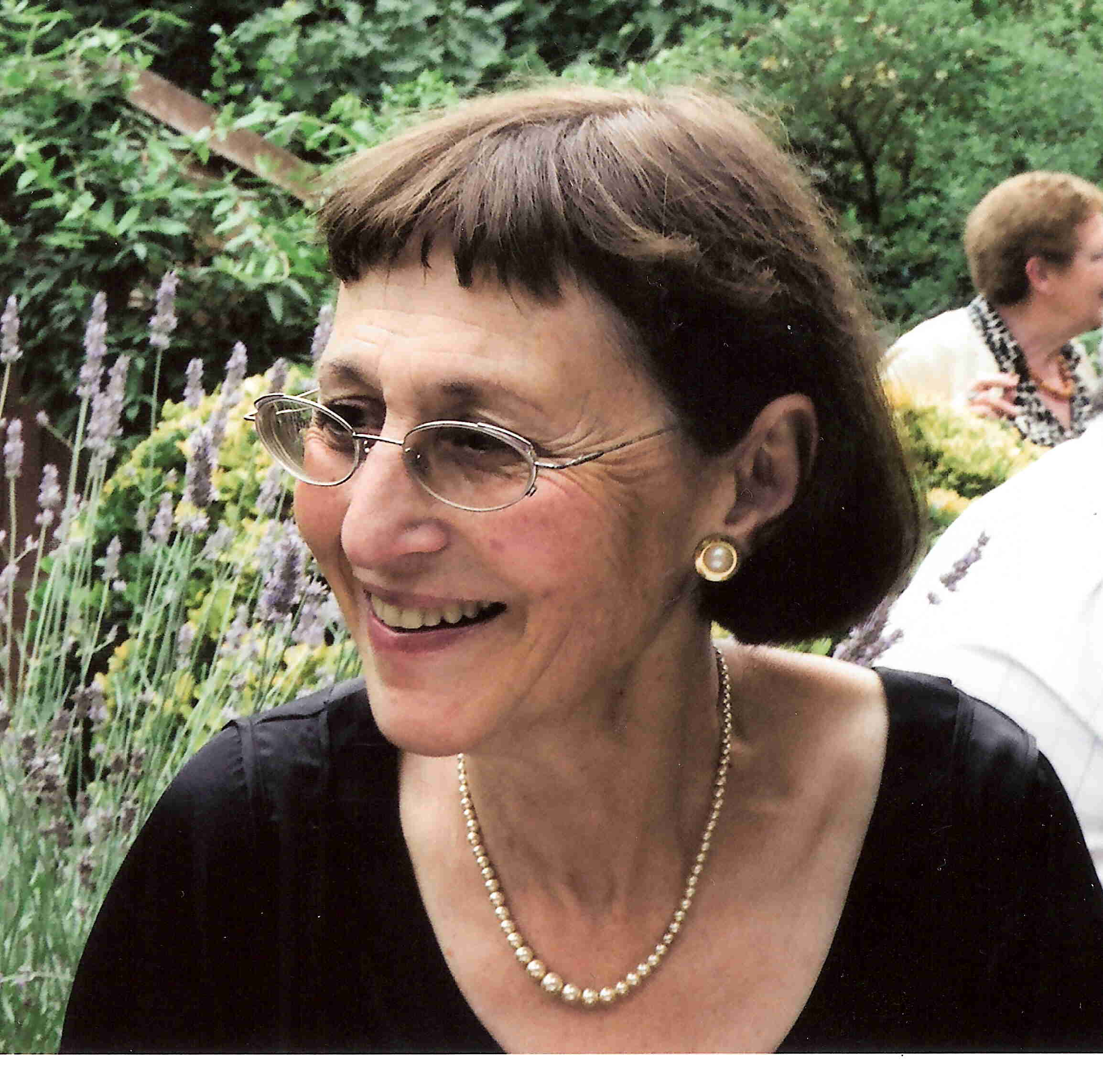
Anna Leung
is a London-based
artist and educator
now semi-retired from
teaching at Birkbeck
College but
taking occasional
informal
groups to current
art exhibitions. Bronze is at the Royal Academy of Arts, London, from 15 September - 9 December 2012 .
|
|
|
